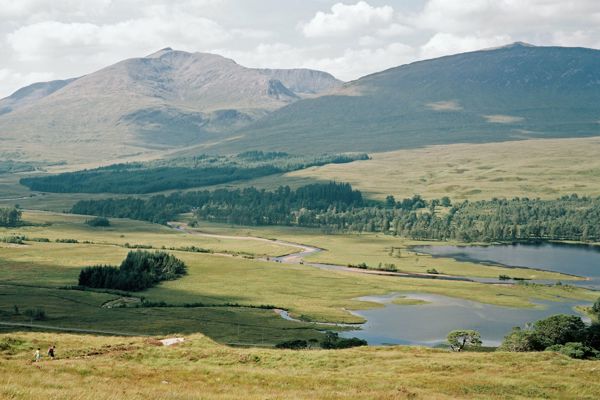It is only a few years ago that I attended a presentation by one of the UK's celebrated land agency businesses at which the concept of natural capital was discussed. I suspect that I was not alone in questioning whether this was something akin to the emperor's new clothes but nothing could have been further from the truth! Throughout the world there are discussions about natural capital and no-one at the conference required a definition of the term.
The Scottish Government has defined natural capital as "the renewable and non-renewable stocks of natural assets, including geology, soil, air, water, and plants, and animals that combine to yield a flow of benefits to people." The Scottish Land Commission has said "In other words it is the capital assets that nature provides us all for free."
Dieter Helm in 2022 stated that "In economic terms natural capital can be considered a 'public good'".
Returning to the differences between England and Scotland I covered four aspects, physical, legal, taxation and political. but first I quoted from Sir Walter Scott's poem - The Lay of the Last Minstrel
O Caledonia stern and wild
Meet nurse for a poetic child!
Land of the heath and shaggy wood,
Land of the mountain and the flood
Physical
Landcover in Scotland differs from much of the rest of the UK. While more than half of England, Wales and Northern Ireland comprises pastures and arable land, Scotland is predominantly covered by peat bogs, moor and forest.
In a recent report by Biggar Economics (commissioned by Scottish Land and Estates and entitled The Contribution of Rural Estates to Scotland's Wellbeing Economy) they commented that Scotland has around 1,125 rural estates over a combined area of approximately 4.1 million hectares - around 57% of Scotland's rural land. That is a great deal of land when you consider that Wales is 2.0 million hectares. I am not sure why commentators always use Wales as a comparator!
Biggar Economics also state that it is estimated that rural estates in Scotland account for 57% of Scotland's installed renewable energy capacity.
Legal
The legal systems of England and Scotland differ in many ways, especially in property law. The areas of Crofting and Agricultural tenancies are particularly different.
Taxation
The Scotland Act 1998 transferred power to the Scottish Government to legislate for local taxation and also the power to vary income tax by plus or minus 3 pence in the pound. There is also a difference between Stamp Duty Land Tax (England) and Land and Buildings Transaction Tax (Scotland) but in capital taxation terms there is no real difference.
Having said that in the recent Consultation Paper, entitled; Land Reform in a Net Zero Nation (Part 12) there is the following statement: "The(y) [Scottish Land Commission] have recently considered the potential role of taxation in respect of land reform."
Political
Since the Scottish Parliament was reconvened in 1999 there has been a spate of land reform. Community engagement has been one of the key policies, starting in 2016 with the Scottish Land Rights and Responsibilities Statement. There was little mention of natural capital, but when the statement was refreshed in 2022, there is the following vision;
"A Scotland with a strong and dynamic relationship between its land and its people, where all land contributes to a modern, sustainable and successful country, supports a just transition to net zero, and where rights and responsibilities in relation to land and its natural capital are fully recognised and fulfilled."
There follows seven principles which are widely drawn.
In March 2022, Scottish Government also issued its Interim Principles for Responsible Investment in Natural Capital where they set out their ambitions and expectations for a values-led, high integrity market for responsible private investment in natural capital to communities, investors, landowners, public bodies and other market stakeholders.
In March 2023, The Scottish Land Commission issued a set or protocols under the title; Responsible Natural Capital and Carbon Management. As others have identified (Robert Scott-Dempster in Scottish Land and Estates Spring 2023 edition of LandBusiness) that the current guidance-led, voluntary approach is being actively questioned by Scottish Government.
In England there is the Environment Act 2021, which contains detailed provisions covering, amongst other issues, 'Improving the natural environment' 'Nature and biodiversity', and 'Conservation covenants'. Little of that act relates to Scotland and where it does the impact is very modest.
Scotland chose a different path and passed the UK Withdrawal from the European Union (Continuity) (Scotland) Act 2021 which contains a series of guiding principles taken, mainly, from the European Union. Having said that, in December 2022 Scottish Government published a Scottish Biodiversity Strategy in which it promises a Natural Environment Bill. The following is their comment:
"A Natural Environment Bill which will contain provisions to put in place statutory targets for nature restoration that cover land and sea and a framework for setting, monitoring, enforcing and reporting on those targets…. They will be based on the overarching goal of this Strategy of halting biodiversity loss by 2030 and restoring Scotland's natural environment by 2045."
This looks like a move from expectations to enforceable targets.
Biodiversity (net) gain
The lead presenter on the above topic (Ben Sharples) produced a large number of slides on this topic and it was evident that in England the issue of biodiversity net gain has become a really important legal topic. Indeed it has just been reported that on 24 March 2023 Natural England published the Biodiversity Metric, which is expected to become mandatory to use once laid before Parliament, likely in November 2023. Unless Scottish Government chooses to adopt these metrics, they will not be for use in Scotland.
In England the metric will be used to a) calculate the biodiversity value pre- and post- development and b) determine what habitat enhancement (on or off-site) needs to be delivered and/or what credits need to be purchased in order to deliver the mandatory 10% biodiversity gain objective.
The above were required under the Environment Act 2021.
The Scottish approach
Scotland's approach to addressing biodiversity attached to development is through the planning system and will be based on enhancement rather than gain. Biodiversity credits (as contemplated in England) are not, currently, in contemplation. National Planning Framework 4 was published on 13 February 2023. Unlike England, Scotland is not proposing to have a nationally set minimum level of biodiversity enhancement. Neither does the approach adopt the use of a biodiversity metric model to calculate the required level of biodiversity provision. This will be a matter for the discretion of each local planning authority. The possibility of off-site enhancement is not ruled out. Ideally on-site enhancement should be carried out, but off-site enhancement is likely to be accepted as an alternative. There is no suggestion that the Scottish Government is considering a biodiversity credit system.
There are examples of local planning authorities, notably Aberdeen and the Borders, taking action. There is also a real likelihood that developers will want to link with landowners to agree off-site enhancement programmes. Offsetting and habitat banking are also likely outcomes.
I understand that Scottish Borders Council in collaboration with a number of project partners have developed a biodiversity off-set scheme to deal with such enhancement off-site.
This does beg the question, in the absence of agreed metrics, how will a local planning authority manage to gauge the level of biodiversity enhancement required?
A fascinating example of on-site enhancement is an SSE development in Thurso. The project was the development of a substation to reinforce the electricity transmission network allowing connection of renewable generation projects in the north of Scotland. The site was known to be low in plant diversity and of low ecological value. Although this development was before any of the current debate about biodiversity net gain/enhancement, the planning permission required tree planting to screen the substations and a generic wildflower mix was specified. This was purely landscape mitigation.
However SSE identified that changes to the consented landscape plan would present an opportunity to enhance local biodiversity. After consultations with local wildlife experts changes to the landscape plan were made to benefit the Great Yellow Bumblebee - a rare endemic species found only in Northern Scotland. Biodiversity gain/enhancement in action!
Carbon markets
The Woodland Carbon Code and the Peatland Code (now in version 2.0 - published in March 2023) are the only carbon codes currently operating in Scotland. They operate equally in Scotland as in England. There is significant activity in identifying and developing opportunities under each code. Land agents, specialist firms and lawyers are building up considerable expertise in handling these codes and the agreeing styles of legal documents required.
Some woodland investors are looking at alternative woodland planting regimes and moving away from the standard commercial planting involving sitka spruce, larch etc. Indeed I know of one large scale investor who has instructed their land agent to run a comparison between the benefits and disadvantages of planting one type of regime against another.
From my conversations with several investors, I know of no-one who is proposing to sell their carbon units - not least because it is a feature of each code that projects are expected to have relatively long durations with long term commitments. Change of ownership over the course of the project, the risk of natural events such as storms and fire all raise questions so careful appraisal is required. If these codes are being used to determine carbon neutrality, then their disposal would have adverse consequences.
The impact on land prices of large-scale acquisitions by corporate, investment and educational organisations has had a significant impact on the price of, often, wild open hill-land. There are many examples of land being sold for multiples of their anticipated values. I sense that this trend is unsustainable but these purchases at high prices has certainly unsettled the market.
Agricultural issues
Following Brexit, England and Scotland have gone their separate ways in terms of agricultural subsidies. In England they have abandoned the EU common agricultural policy (CAP) of providing farmers with incentives based mainly on the acreage farmed. Instead they propose to reward farmers for protecting nature and improving the environment. Environmental Land Management Schemes (ELMS) are the order of the day.
Scotland has yet to issue its proposals so, for the time being, the basic payment scheme continues although this will come to an end by 2025. This scheme does deliver environmental and other benefits by requiring farmers to carry out certain environmental practices and farm in a sustainable way - known as Agricultural Practices Beneficial for the Climate and the Environment - otherwise known as 'greening'.
In addition there is an Agri-Environment Climate Scheme which has been extended to 2024. This scheme promotes land management practices which are designed to protect and enhance Scotland's natural heritage, improve water quality, manage flood risk and mitigate and adapt to climate change.
Regenerative farming
The Scottish Government wants to transform how farmers in Scotland farm so as to become 'a global leader in sustainable and regenerative agriculture'. This is designed to underpin Scotland's future agricultural support regime from 2025 onwards. Included in this plan there are the following proposals:-
- Integrate enhanced conditionality of at least half of all funding for farming and crofting by 2025
- Targeted outcomes for biodiversity gain and low emissions production
- Design support mechanisms to support outcomes that restore nature, benefit our natural capital and promote the natural economy
The farming industry in Scotland awaits the proposals with bated breath.
Agricultural Tenants' Interests
Peatland restoration
As part of the Scottish Land Commission there is a Tenant Farming Commissioner. The Commissioner has produced an excellent Interim Guide to Securing Tradeable Carbon Credits in an Agricultural Holdings Situation.
The Commissioner has correctly identified that as far as Peatland Restoration is concerned it is not included in the definition of agriculture but since 2003 conservation activities are considered to be within the rules of good husbandry. The effect of this is that agricultural tenants are entitled to engage in a range of conservation activities without falling foul of the rules of good husbandry. Accordingly, the Commissioner believes that "it would seem logical, therefore, that peatland restoration, grant aided by Government, would qualify as a conservation activity which can be carried out by the tenant without the need for it to be treated as a diversification (non-agricultural) activity."
However, an application for grant-aid from NatureScot for peatland restoration must have the support of the landlord.
Woodland creation
The legal definition of agriculture allows agricultural tenants to create small farm woodlands and shelter belts without the need for landlord's approval.
Larger woodland creation is deemed to be diversification requiring landlord's consent.
As with peatland restoration the rules of the Woodland Carbon Code require the tenant to have the support of the landlord for the duration of the project and beyond.
There are interesting issues surrounding resumption which apply equally to each code.
In each of the above situations a collaborative approach between the tenant and the landlord is strongly advised. The Commissioner states as follows:
"There is ample incentive for the parties to get together to explore the possibility of entering into a contractual agreement that enables a project to proceed in a way that benefits both parties."
Crofting
Crofting was the outcome of the Highland Clearances and is a type of highly regulated land tenure specific to Scotland. The majority of crofts exist in areas where there is an abundance of peat, so peat restoration is of significant interest. In essence, crofting is a form of tenancy where, very often, the crofting tenants share common grazings. The crofting tenants have statutory rights in the common grazings which, typically, include the right to take peats as a pertinent of their tenancy. In some areas, such as the Western Isles and Shetland, the taking of peats remains an important part of crofting life.
The landlords of these crofts and common grazings also have right to take peats (Section 11 of Schedule 2 of the Crofters (Scotland) Act 1993). However the 1993 Act has no provision for the landlord to enter into a third-party agreement, such as would be required in respect of commercialising the carbon within the peatlands.
Morton Fraser has been commissioned by one of the major crofting landlords to give an opinion on how landlords can enter into peatland restoration under the Peatland Code.
Croft land (including common grazings) may be resumed through an application by a landlord to the Scottish Land Court. It is not a given that the Scottish Land Court will authorise resumption, but the view adopted is that unless specific legislative change is brought into place which deals specifically with the issue of peatland restoration then the only option open to crofting landlords is to proceed by way of a temporary resumption in terms of the Crofting Acts.
Inevitably, the best way forward is to secure the support of the crofters in the longer-term restoration plans and provide them with compensation in terms of the loss of ground grazing. A big question is what level of activity should be permitted on the ground once the period of restoration has been completed and the temporary resumption period has come to an end.
Conclusion
This discussion has touched on various novel issues related to natural capital, biodiversity, carbon sequestration and agri-environment issues that have gained attention in recent times due to their increasing relevance and intricacy. It is not in-depth, and as the landscape is changing rapidly, it is subject to weekly, if not daily, updating. However, I hope that it is an interesting snapshot of the Scottish perspective of the issues.


